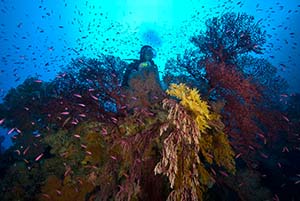May 19 2009
What may become the world's largest marine protected area came a step closer today following the announcement by Australia’s environment minister Peter Garrett that the Coral Sea would become a Conservation Zone.
 Diver in Corals (C) WWF / Mark Spencer
Diver in Corals (C) WWF / Mark Spencer
The area, which is found east of Australia’s Great Barrier Reef Marine park and amounts to almost a million square kilometers, is home to significant seabirds and migratory marine species, and has remained relatively undisturbed by direct human impact.;
“The Coral sea is one of the world’s healthiest marine wilderness areas, where it is still possible to see healthy populations of sharks, turtles, whales, fish and coral” said Lydia Gibson, WWF’s Marine Policy Manager in the region.
“WWF has been working hard to make sure this region receives the recognition it deserves.”
Under the conservation zone designation, current tourism and fishing activities can continue, but new commercial activity will be rigorously assessed while the government evaluates the region for its conservation value.
WWF worked with government and stakeholders to develop a set of criteria which Mr. Garrett says will be included in the final plan for the conservation of the Coral Sea.
“The pressures on our oceans are increasing and we need to take steps to protect our fragile marine environments,” Mr Garrett.
These criteria include the establishment of the protected area by 2011, ruling out oil and gas exploration and the creation of high-conservation zones within the Marine Protected Area.
This news comes shortly after the commitment last week by the six leaders of the Coral Triangle countries – Indonesia, Malaysia, Papua New Guinea, the Philippines, Solomon Islands and Timor Leste – to protect the region by implementing a 10-year regional plan of action with time-bound steps to address growing threats to the region’s threatened species and other marine and coastal living resources.
“As climate change begins to effect ecosystems around the world, including the Coral Sea, marine protected areas provide a buffer zone, allowing species to adapt to the changes. WWF would like to see a chain of interconnected marine protected areas across the world, giving marine species the greatest chance of survival” said Ms. Gibson.
The existing Coral Sea national nature reserves – Coringa-Herald and Lihou Reef reserves, and the Great Barrier Reef Marine Park, are not included in the conservation zone.